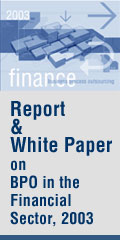|


|
Fundamental credit outlook for the Indian banking system is stable-Moody's
India's banks have benefited from the strong economic cycle driving a surge in loans and providing considerable growth potential. The consequent increase in competition -- with the public sector banks (PSBs) losing some market share to private sector institutions and, to a lesser extent, foreign banks -- should also result in a more efficient and transparent banking system, says Moody's Investors Service in its new Banking System Outlook report for India.
The fundamental credit outlook for the Indian banking system is stable, according to Moody's. This outlook expresses the rating agency's view on the likely future direction of fundamental credit conditions in the industry over the next 12 to 18 months. It does not represent a projection of rating upgrades versus downgrades.
"For many rated PSBs, a key challenge -- and rating constraint -- remains their ability to modernise by upgrading their technological platforms and capabilities through branch computerisation and implementation of a core banking solution. Outdated human resource structures and rigid and inefficient labour forces also limit the PSBs' ability to attract talent and compete on equal terms with their more modern counterparts," explains Nondas Nicolaides, a Moody's Vice President / Senior Analyst and author of the report.
Overall loan growth in the Indian banking system remains robust but has slowed somewhat, largely due to a significantly lower increase in retail loans, the driving force of growth for many banks in recent years. Moody's cautions that the retail loans have yet to be fully tested in a negative credit cycle and that certain banks may not have the comprehensive credit scoring and monitoring systems and tools in place for closely screening retail loans, which could prove challenging as delinquency rates have started rising in recent months.
"A positive and important rating driver for all the rated Indian banks, in particular the PSBs, is their robust deposit franchises, assuring them of a relatively cheap and stable source of funding and a comfortable liquidity profile. In terms of efficiency, Indian commercial banks boast a cost-to-income ratio of around 50% that compares favourably with the ratios of other international banks," Mr Nicolaides says. The recent global credit crisis and liquidity crunch in the financial markets has had very limited to no impact on Indian banks. Only certain large banks with international operations have been mildly affected by asset price adjustments and have taken some minimal write-downs because of the widening of spreads.
The profitability ratios of Indian commercial banks are relatively moderate but their core recurring income and profits are on a rising trend. PSBs display marginally lower profitability than their private sector counterparts, while foreign banks in India appear to be the most profitable. Going forward, the increasing disintermediation and competition for good-quality credits could exert some pressure on revenue streams. A focus on increasing fee-based income will be key to improving quality of earnings and maintaining future profitability.
Most Indian banks demonstrate healthy capital adequacy ratios. The key concern remains the ability of the weaker PSBs and those PSBs that are close to the threshold of minimum government shareholding as well as small private sector banks to raise fresh capital, especially in view of the adoption of the Basel II accord. This could induce some level of consolidation in the market going forward.
The banking system's steady improvement in asset quality in recent years has been exerting upward pressure on the BFSRs of the rated banks despite the sharp rise in credit growth. However, loan restructuring carried out in recent years across the system and the seasoning of the relatively new lending could indicate that the actual level of NPLs may be higher, just as the March 2008 year-end results suggest for a number of rated banks. Looking ahead, any rapid material deterioration in banks' asset quality that placed pressure on their profitability and solvency positions could prompt Moody's to change the rating outlook for the affected banks to negative from stable.
(This is press release of Moody's Investors Service)
Global credit quality worsens in first quarter 2008
Current challenges in the global financial markets
Losses resulting from mortgage fraud in US will reach $2.5 billion in 2008
Highest levels of political and economic uncertainty in 2008
No immediate threat to financial stability in India
CLICK FOR MORE FEATURES & STORIES


|
|



|








